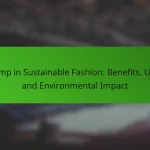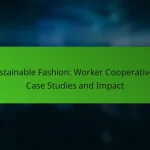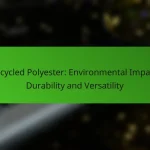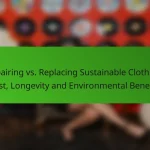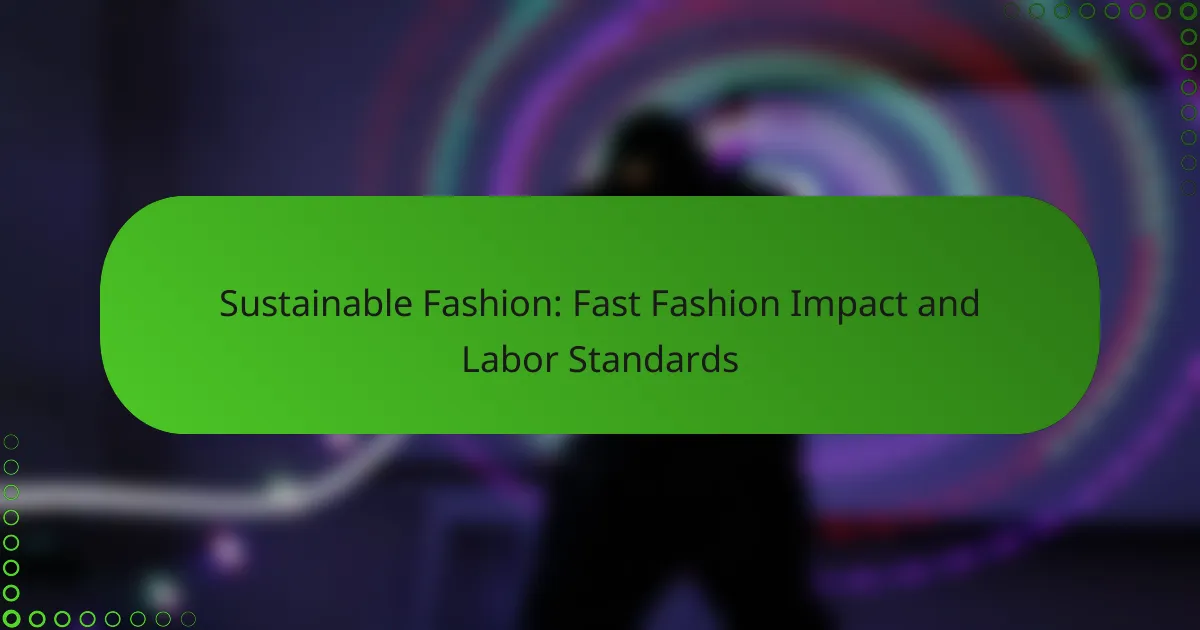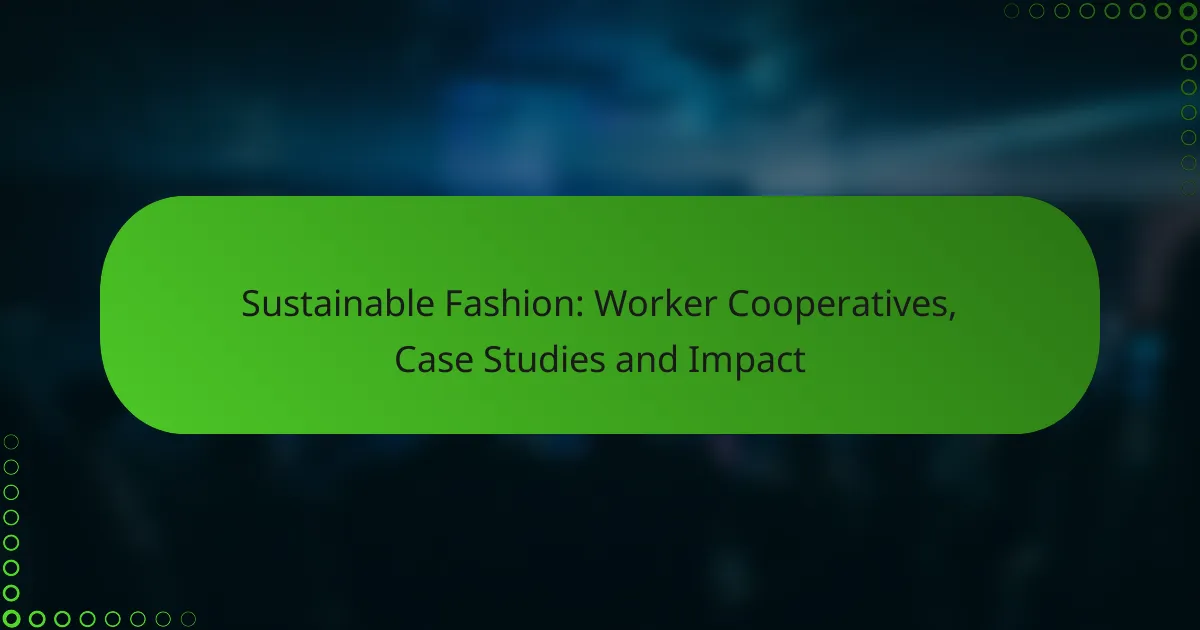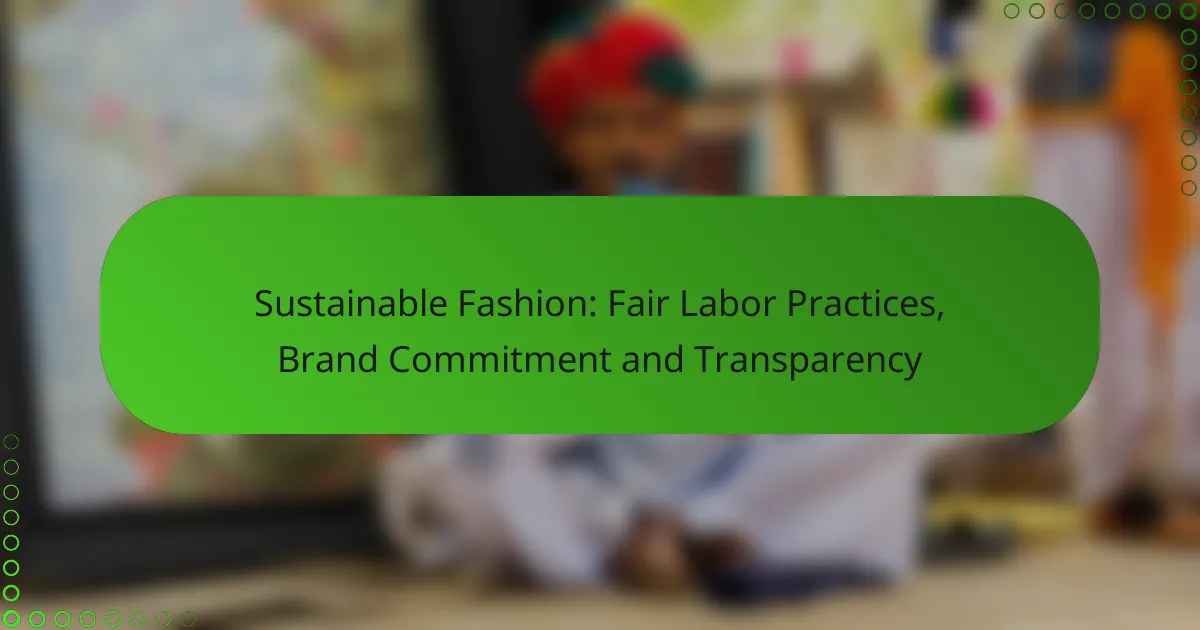Sustainable fashion is increasingly crucial as fast fashion’s rapid production cycles lead to significant environmental degradation and social injustices. The industry often compromises labor standards, exposing workers to unsafe conditions and low wages. By exploring ethical alternatives such as sustainable brands and second-hand shopping, consumers can make choices that support both the planet and fair labor practices.

How does fast fashion impact sustainability in the UK?
Fast fashion significantly undermines sustainability in the UK by promoting rapid production cycles that prioritize low costs over environmental and social responsibility. This results in detrimental effects on ecosystems, resource availability, and waste management systems.
Environmental degradation
Fast fashion contributes to environmental degradation through the extensive use of harmful chemicals in textile production and the pollution of water bodies. The fashion industry is a major source of water pollution, with dyes and toxins often released untreated into rivers.
Additionally, the demand for cheap clothing leads to deforestation and habitat destruction as land is cleared for cotton farming and other textile materials. This loss of biodiversity further exacerbates climate change and disrupts local ecosystems.
Resource depletion
The fast fashion model relies heavily on finite resources, particularly water and fossil fuels. For instance, producing a single cotton t-shirt can require thousands of liters of water, straining local water supplies, especially in regions already facing scarcity.
Moreover, the reliance on synthetic fibers, derived from petroleum, contributes to the depletion of non-renewable resources. As the demand for fast fashion grows, so does the pressure on these essential materials, leading to unsustainable extraction practices.
Waste generation
Fast fashion is a leading contributor to textile waste, with millions of tons of clothing ending up in landfills each year in the UK. Many garments are discarded after only a few wears, as trends change rapidly and consumers seek the latest styles.
To combat this, consumers can adopt more sustainable practices, such as buying second-hand clothing, recycling old garments, or choosing brands that prioritize circular fashion. Implementing these strategies can help reduce the overall waste generated by the fashion industry.

What are the labor standards in the fast fashion industry?
The labor standards in the fast fashion industry are often inadequate, with many workers facing low wages, unsafe working environments, and exploitative practices. These conditions raise significant ethical concerns about the sustainability of fast fashion and its impact on workers’ rights.
Wages below living standards
Many fast fashion workers earn wages that fall below the minimum living standards necessary for basic needs. In countries like Bangladesh and India, garment workers may receive salaries that are only a fraction of what is required to cover essential expenses such as food, housing, and healthcare.
This wage disparity leads to a cycle of poverty, where workers struggle to make ends meet, often working excessive hours without overtime pay. Brands that rely on these labor practices contribute to systemic economic inequality.
Poor working conditions
Fast fashion factories frequently operate under poor working conditions, characterized by overcrowded spaces, inadequate ventilation, and insufficient safety measures. Workers may be exposed to harmful chemicals and face risks of accidents due to lack of proper equipment.
These unsafe environments not only jeopardize the health of employees but also lead to high turnover rates and decreased productivity. Brands must prioritize improving these conditions to ensure the safety and well-being of their workforce.
Child labor prevalence
Child labor remains a significant issue in the fast fashion industry, particularly in developing countries. Many children are employed in garment factories, often working long hours for meager pay instead of attending school.
This exploitation denies children their right to education and a better future. Companies must take responsibility by enforcing strict policies against child labor and supporting initiatives that promote education and fair labor practices.
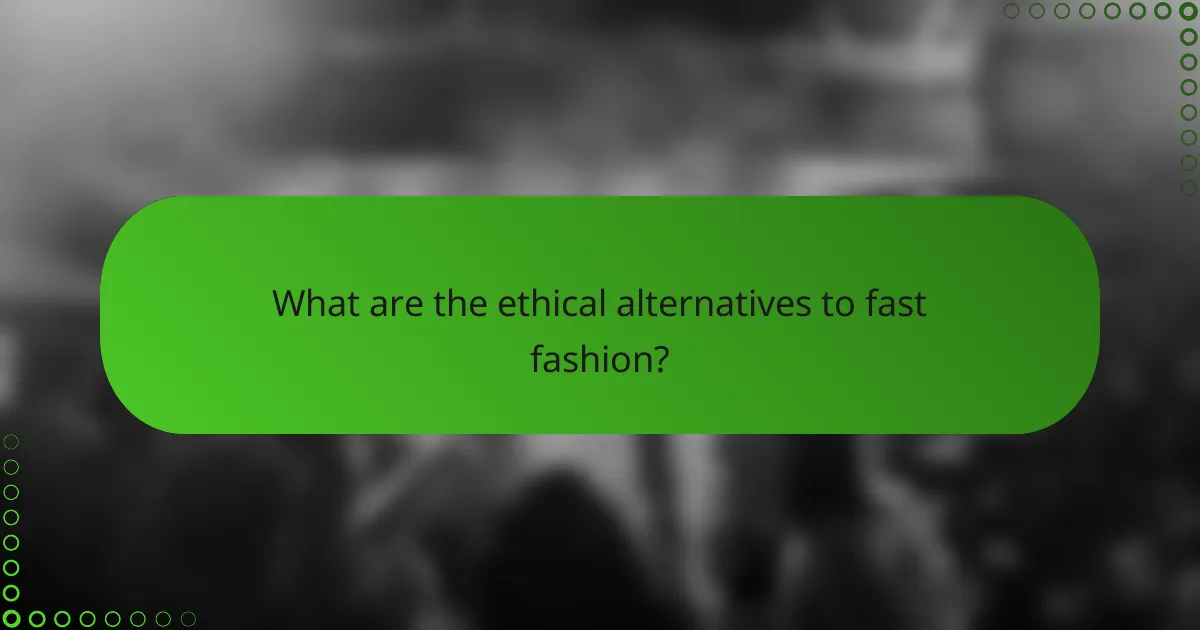
What are the ethical alternatives to fast fashion?
Ethical alternatives to fast fashion include sustainable brands, second-hand shopping platforms, and rental services. These options prioritize environmental responsibility and fair labor practices, offering consumers a way to shop that aligns with their values.
Sustainable brands like Stella McCartney
Sustainable brands, such as Stella McCartney, focus on eco-friendly materials and ethical production methods. They often use organic cotton, recycled fabrics, and non-toxic dyes, ensuring that their clothing has a lower environmental impact.
When choosing sustainable brands, look for certifications like GOTS (Global Organic Textile Standard) or Fair Trade. These labels indicate adherence to strict environmental and labor standards, providing assurance that your purchase supports ethical practices.
Second-hand shopping platforms
Second-hand shopping platforms, such as ThredUp and Poshmark, allow consumers to buy pre-owned clothing, reducing waste and extending the lifecycle of garments. These platforms often feature a wide variety of styles at lower prices compared to new items.
Shopping second-hand can be a treasure hunt, but it’s essential to check the condition of items and verify seller ratings. This approach not only saves money but also promotes a circular economy by keeping clothing out of landfills.
Rental services like Rent the Runway
Rental services, such as Rent the Runway, provide access to high-quality clothing for a fraction of the retail price. This model allows consumers to wear designer pieces for special occasions without the commitment of a purchase.
When using rental services, consider the rental duration and any associated fees. This option is particularly beneficial for those who want to refresh their wardrobe regularly without contributing to fast fashion’s environmental toll.

How can consumers promote sustainable fashion practices?
Consumers can promote sustainable fashion practices by making informed choices that prioritize eco-friendly materials, support ethical brands, and engage in clothing swaps. These actions help reduce the environmental impact of fashion and improve labor standards in the industry.
Choosing eco-friendly materials
When selecting clothing, look for items made from organic or recycled materials, such as organic cotton, Tencel, or recycled polyester. These materials typically have a lower environmental footprint compared to conventional fabrics.
Additionally, consider the production processes involved. Fabrics dyed with natural dyes or produced using less water and energy are often more sustainable. Checking for certifications like GOTS (Global Organic Textile Standard) can also guide your choices.
Supporting ethical brands
Purchasing from brands that prioritize fair labor practices and transparency in their supply chains is crucial. Look for companies that provide information about their workers’ conditions and pay fair wages.
Research brands that are certified by organizations like Fair Trade or those that have a strong commitment to sustainability. Supporting local artisans or small businesses can also contribute positively to ethical fashion.
Participating in clothing swaps
Clothing swaps are a practical way to refresh your wardrobe without contributing to fast fashion. Organize or join local swap events where participants exchange gently used clothing, allowing everyone to find new pieces while reducing waste.
These events not only promote sustainability but also foster community connections. Consider hosting a swap with friends or family to make it a fun and social experience.
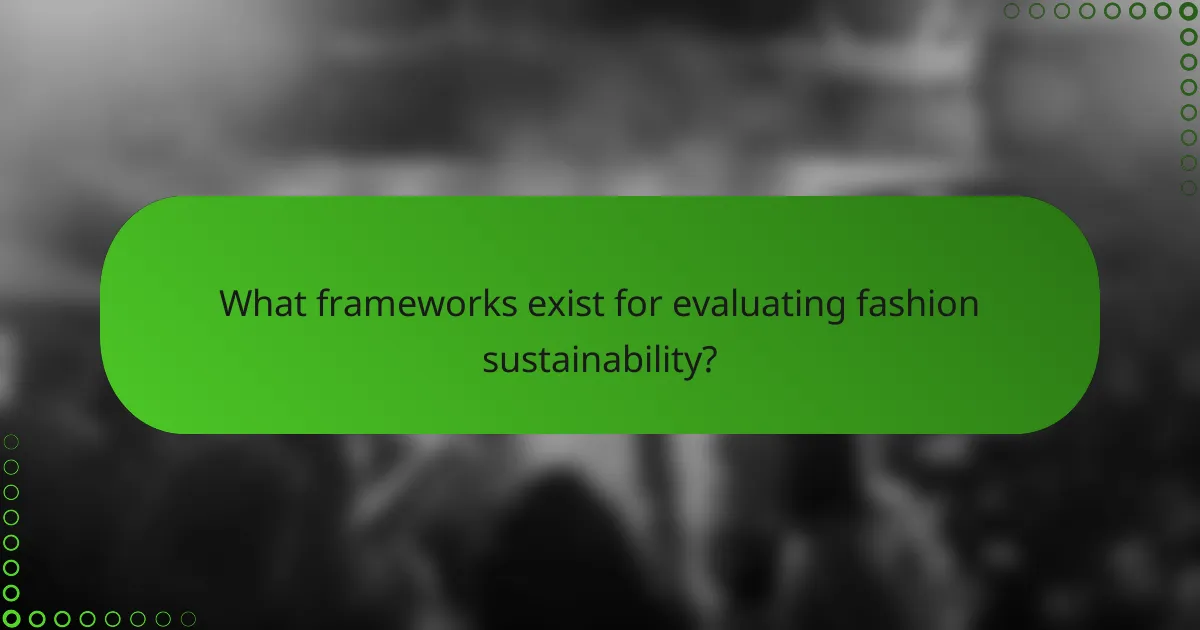
What frameworks exist for evaluating fashion sustainability?
Several frameworks help assess fashion sustainability, focusing on environmental impact, labor standards, and ethical practices. These tools provide brands and consumers with insights into sustainable practices and guide decision-making in the fashion industry.
Higg Index
The Higg Index is a suite of tools developed by the Sustainable Apparel Coalition to measure the environmental and social performance of apparel and footwear. It evaluates various aspects, including water usage, greenhouse gas emissions, and labor conditions, allowing brands to identify areas for improvement.
Brands can use the Higg Index to benchmark their sustainability efforts against industry standards. For example, a company might discover that its water usage is significantly higher than the average, prompting them to adopt more efficient practices. This index is widely recognized and used by many leading fashion brands.
Global Organic Textile Standard (GOTS)
The Global Organic Textile Standard (GOTS) is a leading textile processing standard for organic fibers, ensuring that textiles are made from organic materials and produced in environmentally and socially responsible ways. GOTS certification covers the entire supply chain, from harvesting of raw materials to labeling and trading.
To achieve GOTS certification, a product must contain at least 70% organic fibers and meet strict criteria for chemical use, wastewater treatment, and labor conditions. Brands that are GOTS certified can appeal to eco-conscious consumers and differentiate themselves in a competitive market.

How does fast fashion affect labor rights globally?
Fast fashion significantly undermines labor rights worldwide by prioritizing low production costs over fair working conditions. This often results in exploitation, unsafe environments, and inadequate wages for workers, particularly in developing nations.
Exploitation in developing countries
In many developing countries, fast fashion brands often rely on cheap labor to maximize profits. Workers may face long hours, minimal pay, and unsafe working conditions, with wages frequently falling below the local living wage. For example, garment workers in countries like Bangladesh or Cambodia may earn as little as $100 per month, which is insufficient to cover basic living expenses.
The lack of enforcement of labor laws in these regions exacerbates the situation, allowing companies to exploit workers without facing significant repercussions. Many workers are also denied basic rights such as unionization, further limiting their ability to advocate for better conditions.
Impact of trade agreements
Trade agreements can significantly influence labor standards in the fast fashion industry. While some agreements aim to improve labor rights, others prioritize economic benefits, often at the expense of workers. For instance, agreements that lower tariffs on imports can encourage brands to outsource production to countries with weaker labor regulations.
Additionally, the push for free trade can lead to a race to the bottom, where countries compete to offer the lowest production costs, thereby neglecting labor rights. Consumers can advocate for better practices by supporting brands that prioritize ethical sourcing and transparency in their supply chains.

What are the emerging trends in sustainable fashion?
Emerging trends in sustainable fashion focus on reducing environmental impact and improving labor standards. Key developments include the rise of eco-friendly materials, circular fashion practices, and transparency in supply chains.
Eco-friendly materials
Eco-friendly materials are gaining traction as brands seek to minimize their carbon footprint. Organic cotton, Tencel, and recycled polyester are popular choices that reduce reliance on harmful chemicals and non-renewable resources. Consumers are increasingly looking for certifications, such as GOTS (Global Organic Textile Standard) and OEKO-TEX, to ensure the sustainability of these materials.
Circular fashion practices
Circular fashion practices aim to extend the lifecycle of clothing through recycling, upcycling, and rental services. Brands are adopting take-back programs that encourage consumers to return used garments for recycling or resale. This approach not only reduces waste but also promotes a more sustainable consumption model.
Transparency in supply chains
Transparency in supply chains is becoming a critical expectation among consumers. Brands are now required to disclose information about their sourcing, production processes, and labor conditions. This shift encourages ethical practices and allows consumers to make informed choices about their purchases, fostering accountability within the fashion industry.

